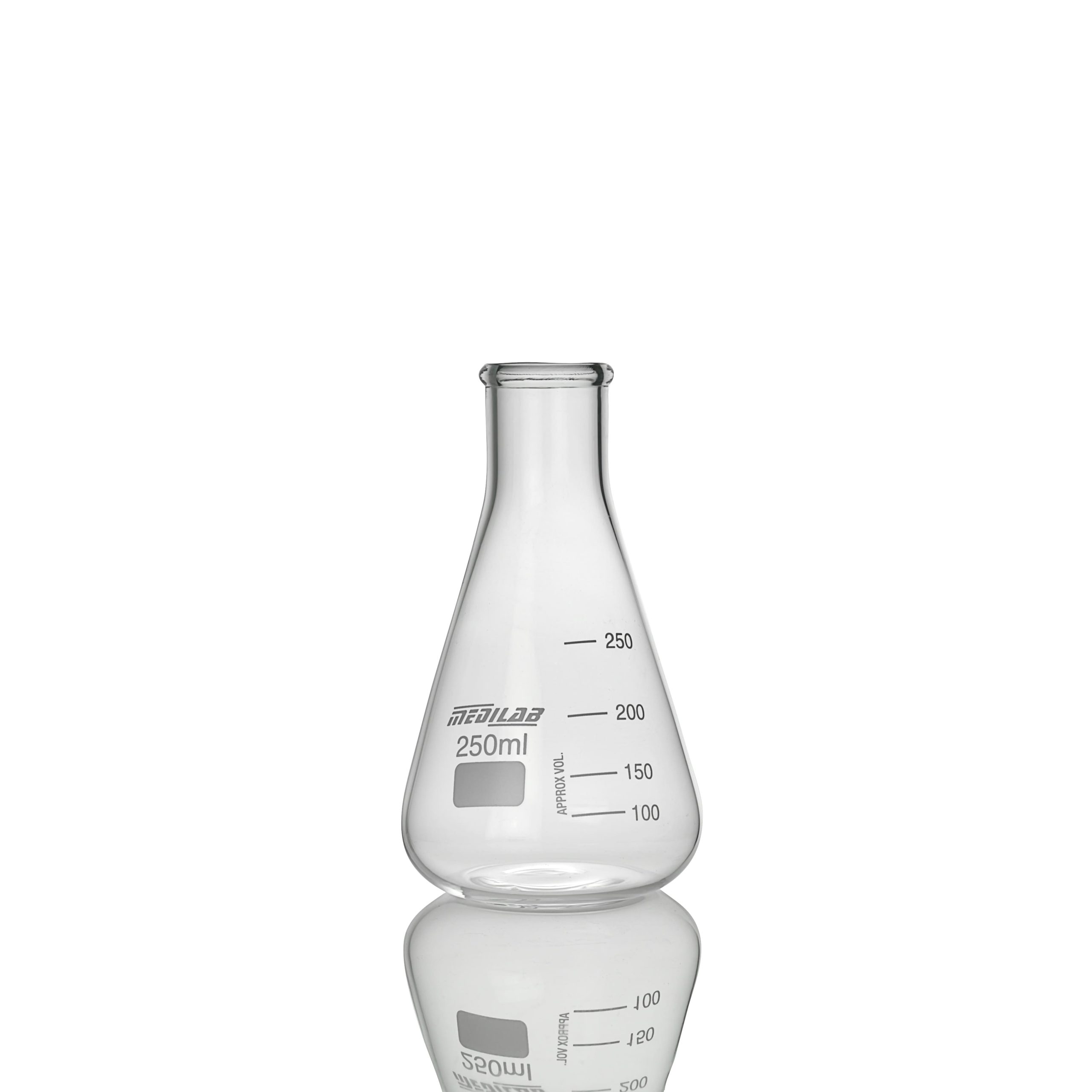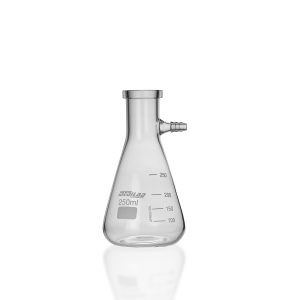Description
| Catalog No. | Capacity ml | Body dia | Neck Dia. mm | Height |
| 11003/1 | 25 | 42 | 22 | 75 |
| 11003/2 | 50 | 51 | 22 | 90 |
| 11003/3 | 100 | 64 | 22 | 105 |
| 11003/3.1 | 150 | 74 | 28 | 118 |
| 11003/4 | 250 | 85 | 34 | 145 |
| 11003/5 | 500 | 105 | 34 | 180 |
| 11003/6 | 1000 | 131 | 42 | 220 |
| 11003/7 | 2000 | 166 | 50 | 280 |
| 11003/7.1 | 3000 | 187 | 50 | 310 |
| 11003/8 | 5000 | 220 | 50 | 365 |
| 11003/9 | 10000 | – | – | – |
The MEDILAB Erlenmeyer Flask (Narrow Neck) is a conical laboratory vessel designed for mixing, heating, culturing, and storing liquids with superior control and safety. Its tapered body and narrow opening minimize evaporation, reduce spill risk, and enable efficient swirling without splashing. Widely used across scientific and industrial workflows, this flask is an essential tool for accurate sample preparation, titrations, microbial culture, and chemical reactions. Built from high-performance Borosilicate Glass 3.3, it ensures durability and long-term reliability in demanding laboratory environments.
Key Features
- Conical body with narrow neck for controlled mixing and reduced risk of spillage.
- High chemical and thermal resistance suitable for heating, cooling, and autoclaving.
- Thick, uniform wall construction ensures mechanical strength and long service life.
- Frosted/ground neck options are available for secure stopper sealing.
- Clear, high-contrast graduations for easy volume estimation.
- Excellent clarity for visual monitoring of reactions and cultures.
- Compatible with standard laboratory clamps, stands, and heating equipment.
- Leak-resistant design when used with compatible stoppers.
Material Specifications
- Material: Borosilicate Glass 3.3
- Thermal Properties:
High thermal shock resistance
Withstands rapid heating/cooling cycles
Ideal for use on hot plates and in autoclaves - Chemical Resistance:
Resistant to most acids, alkalis, solvents, and organic reagents
Non-porous, non-reactive surface prevents sample contamination - Mechanical Strength:
Uniform thickness ensures structural durability
Long life in routine lab use - Standards Compliance:
Manufactured as per ISO 1773 / DIN standards
Technical Specifications
- Available Capacities:
25 ml to 1000 ml (as per the standard size table) - Dimensions:
Capacity-wise dimensions (height, base diameter, neck size) available on request or as per the standard MEDILAB sizing chart - Graduation Accuracy:
Class A or Class B (as applicable)
Clear white enamel graduations - Tolerance:
As per ISO / DIN specifications - Calibration (if ordered):
Individual volume calibration available - Accessories (Optional):
Glass stoppers
Rubber stoppers
Plastic screw caps (for select models)
Handling & Precautions
- Do not expose the flask to direct flame unless specifically designed for flame use; use a wire gauze or heating mantle.
- Avoid sudden temperature changes to maintain glass integrity.
- Suitable for autoclaving up to recommended limits for Borosilicate Glass 3.3.
- Clean using mild laboratory detergents; avoid abrasive scrubbers that may scratch the surface.
- Do not overtighten stoppers or clamps.
- Ensure gradual heating and cooling during experiments.
- Inspect regularly for cracks or chips and replace if damaged to ensure safety.
Applications
- Chemical and reagent preparation in academic and industrial labs
- Titration and volumetric analysis
- Microbial culture and shaking experiments
- Sample storage and media preparation
- Mixing, dissolving, and heating reactions
- Widely used in pharmaceutical, biotechnology, chemical, environmental, food & beverage, QC/QA, and research institutions.
Its versatility makes it a daily-use essential across diverse scientific workflows.







